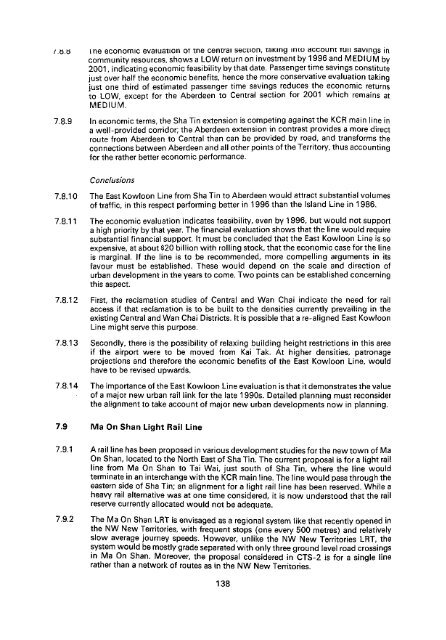Untitled - HKU Libraries - The University of Hong Kong
Untitled - HKU Libraries - The University of Hong Kong
Untitled - HKU Libraries - The University of Hong Kong
- No tags were found...
Create successful ePaper yourself
Turn your PDF publications into a flip-book with our unique Google optimized e-Paper software.
.S.Bi ne economic evaluation or tne central section, TaKing into accouni TUII savings incommunity resources, shows a LOW return on investment by 1996 and MEDIUM by2001, indicating economic feasibility by that date. Passenger time savings constitutejust over half the economic benefits, hence the more conservative evaluation takingjust one third <strong>of</strong> estimated passenger time savings reduces the economic returnsto LOW, except for the Aberdeen to Centra! section for 2001 which remains atMEDIUM.7.8.9 In economic terms, the Sha Tin extension is competing against the KCR main line ina well-provided corridor; the Aberdeen extension in contrast provides a more directroute from Aberdeen to Central than can be provided by road, and transforms theconnections between Aberdeen and all other points <strong>of</strong> the Territory, thus accountingfor the rather better economic performance.Conclusions7.8.10 <strong>The</strong> East Kowloon Line from Sha Tin to Aberdeen would attract substantial volumes<strong>of</strong> traffic, in this respect performing better in 1996 than the Island Line in 1986.7.8.11 <strong>The</strong> economic evaluation indicates feasibility, even by 1996, but would not supporta high priority by that year. <strong>The</strong> financial evaluation shows that the line would requiresubstantial financial support. It must be concluded that the East Kowloon Line is soexpensive, at about $20 billion with rolling stock, that the economic case for the lineis marginal. If the line is to be recommended, more compelling arguments in itsfavour must be established. <strong>The</strong>se would depend on the scale and direction <strong>of</strong>urban development in the years to come. Two points can be established concerningthis aspect7.8.12 First, the reclamation studies <strong>of</strong> Central and Wan Chai indicate the need for railaccess if that reclamation is to be built to the densities currently prevailing in theexisting Central and Wan Chai Districts. It is possible that a re-aligned East KowloonLine might serve this purpose.7.8.13 Secondly, there is the possibility <strong>of</strong> relaxing building height restrictions in this areaif the airport were to be moved from Kai Tak. At higher densities, patronageprojections and therefore the economic benefits <strong>of</strong> the East Kowloon Line, wouldhave to be revised upwards.7.8.14 <strong>The</strong> importance <strong>of</strong> the East Kowloon Line evaluation is that it demonstrates the value<strong>of</strong> a major new urban rail link for the late 1990s. Detailed planning must reconsiderthe alignment to take account <strong>of</strong> major new urban developments now in planning.7.9 Ma On Shan Light Rail Line7.9.1 A rail line has been proposed in various development studies for the new town <strong>of</strong> MaOn Shan, located to the North East <strong>of</strong> Sha Tin. <strong>The</strong> current proposal is for a light railline from Ma On Shan to Tai Wai, just south <strong>of</strong> Sha Tin, where the line wouldterminate in an interchange with the KCR main line. <strong>The</strong> line would pass through theeastern side <strong>of</strong> Sha Tin; an alignment for a light rail line has been reserved. While aheavy rail alternative was at one time considered, it is now understood that the railreserve currently allocated would not be adequate.7.9.2 <strong>The</strong> Ma On Shan LRT is envisaged as a regional system like that recently opened inthe NW New Territories, with frequent stops (one every 500 metres) and relativelyslow average journey speeds. However, unlike the NW New Territories LRT, thesystem would be mostly grade separated with only three ground level road crossingsin Ma On Shan. Moreover, the proposal considered in CTS-2 is for a single linerather than a network <strong>of</strong> routes as in.the NW New Territories.138
















